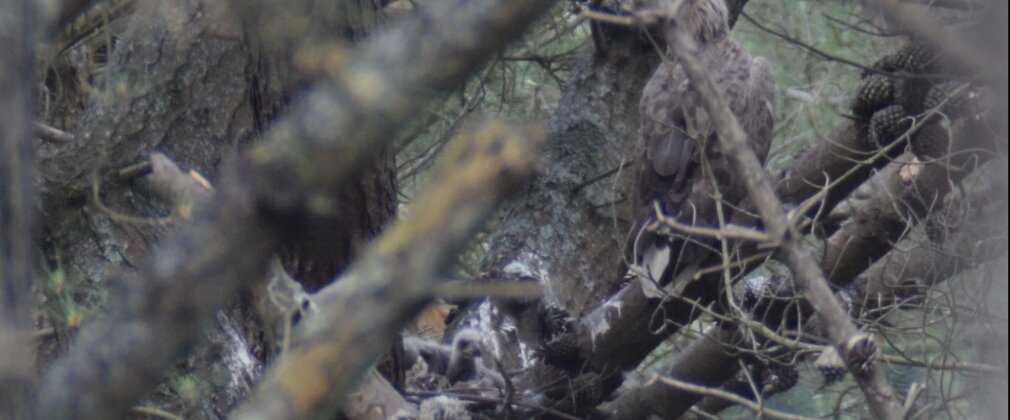
11 August 2025
Record number of wild white-tailed eagle chicks hatched in England
First wild chick to fledge in Dorset for over 240 years
A record three white-tailed eagle chicks have successfully fledged from two wild nests in England. The chicks were reared by white-tailed eagles released in a ground breaking conservation project by Forestry England and the Roy Dennis Wildlife Foundation to return this lost species to England.
Two different pairs of white-tailed eagles successfully bred this year. This included the first chick in Dorset for over 240 years, and two chicks raised in a nest in Sussex.
A single male chick (G834) fledged from a nest in Dorset. The parent birds - G463 and G466 released in 2020 - settled in the county and paired up in 2023. This is their first successful breeding attempt and made more remarkable by the fact that the male adult bird has only one leg after it lost this four years ago.
Two chicks, both females (G841 and G842), fledged this year from a nest in Sussex. Both are the offspring of two white-tailed eagles released by the project in 2020. The parent birds - G405 and G471 – were the same pairing that bred in 2023 and 2024.
This year’s successful breeding brings the number of these iconic birds born in the wild through the project to six. In 2023 a single chick was born, the first in England since the eighteenth century when the species was lost due to persecution. A further two chicks were born in the summer of 2024.
All of the chicks are fitted with satellite tags so that the project team can track their progress. Over the last year they have used satellite data to follow the fledglings as they have explored widely across the UK.
White-tailed eagles typically reach breeding maturity at around four or five years old. From the birds released by the project, three pairs have formed and established territories in southern England. Several of the younger birds are also present in potential future breeding areas typically close to freshwater wetlands or the coast, where the birds can catch fish, which is their preferred food. In time, it is hoped that a population of 6-10 breeding pairs will become established within 60 kilometres of the release site on the Isle of Wight.
Roy Dennis OBE, Founder of the Roy Dennis Wildlife Foundation, said:
“We are delighted to see another year of successful breeding and that two pairs have now reached this key stage. This is a long-term project, and it will take some years before the population is fully restored but the progress made over the last year has been incredibly encouraging. We have some well-established pairs and two that are actively breeding. We hope to build on this progress, and I’m really pleased that we have been able to release an additional 8 birds this year to further boost the population.”
“I always find it particularly rewarding to see so much support for these magnificent birds and the positive impact they are having on so many people’s relationship with the natural world.”
Steve Egerton-Read, White-Tailed Eagle Project Officer for Forestry England, said:
“We have been patiently monitoring these nests for many months and hoping they would be successful. It is always such an exciting time but also incredibly nerve wracking! This was especially the case for the pair of eagles in Dorset who were first time parents. It was an incredible moment when we caught our first glimpse of that tiny fluffy chick in the nest, but equally, it’s an anxious time as the parents get to grips with what they need to do. Ultimately, it has been so rewarding to see this pair of eagles, often spotted in and around Dorset, care for the chick all the way through to it fledging the nest. Now it won’t be long until he is starting his own journey and hopefully one day, he will breed somewhere in southern England.
“Returning lost species like the white-tailed eagle is a key part of Forestry England’s approach to restoring biodiversity and helping nature to recover. We hope that in years to come these iconic birds will become a much more common sight, inspiring future generations and deepening their connection with nature.”
White-tailed eagles are Britain’s largest birds of prey with a wingspan of up to 2.5 metres and were once widespread across England. Human persecution caused their extinction, with the last pair breeding in southern England in 1780. In 2019, Forestry England and the Roy Dennis Wildlife Foundation began reintroducing these iconic birds to the English landscape.
To date, 45 young white-tailed eagles have been released. This includes eight birds released this summer from the team’s base on the Isle of Wight.
The reintroduction of white-tailed eagles is conducted under licence from Natural England, the Government’s wildlife licensing authority. Birds for release are collected from wild nests in Scotland under licence from NatureScot before being transported to England with valuable support from Civil Air Support. The birds are subsequently reared and released on the Isle of Wight, all birds released by the project are fitted with satellite tags.
White-tailed eagles are a protected species under the Wildlife and Countryside Act (1981). Disturbing, destroying or interfering with them and their nests are criminal offences. The specific locations of this year’s nests are not being disclosed for the welfare of the birds and to prevent any disturbance to them or the landowner this year or if the birds return to breed at the same location.
Notes to Editor
- Images and video are available here Please credit Forestry England.
- Forestry England manages and cares for the nation’s 1,500 woods and forests, with over 285 million visits in 2023/24. As England’s largest land manager, we shape landscapes and enhance forests for people to enjoy, wildlife to flourish and businesses to grow. We are continuing the work we have already started to make the nation’s forests resilient to climate change and by 2026 we will:
- create at least 6,000 more hectares where we integrate wilding activities in our productive forests
- increase the diversity of visitors to the nation’s forests and have one million hours of high-quality volunteer time given to the nation’s forests
- plant at least 2,000 hectares of new, high quality woodlands
For more information visit Forestry England.uk. Forestry England is an agency of the Forestry Commission.
- About Roy Dennis Wildlife Foundation
The Foundation was established in Scotland in 1995 as the Highland Foundation for Wildlife. It is a non-membership charitable trust dedicated to wildlife conservation and research, with a special emphasis on species recovery projects and the restoration of natural ecosystems. Its aim is to carry out important work in the field through project-based activity and to keep administrative overheads to a minimum. The first trustees were Sir Charles Fraser, Nigel Graham, John Grant of Rothiemurchus, Lady Lucy Lister Kaye and William Templeton. The present trustees are Jamie Whittle (Chairman), Lady Lucy Lister Kaye, Frank Law and John Nicholson.
The Foundation changed its name in June 2017 to the Roy Dennis Wildlife Foundation to reflect Roy’s inspirational contribution to nature conservation and the international scope of its work.
Media Contact:
Susan Smith
Media Officer, South Forest District, Forestry England
07384 878434
susan.smith@forestryengland.uk
